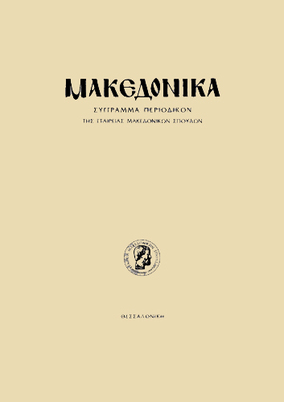Τα Γρεβενά (Συμβολή στην ιστορία τους)
Part of : Μακεδονικά ; Vol.26, 1987, pages 242-307
Issue:
Pages:
242-307
Parallel Title:
Grevena (a contribution to its history).
Section Title:
Articles
Abstract:
Information about this mountainous region of Southwestern Macedonia, which today constitutes, almost in its entirety, the province and prefecture of Grevena and which is located far away from the main land-communication lines, is limited and confused for a period covering many centuries.In ancient times it constituted part of Tymphea, one of the big provinces of Upper Macedonia, which contributed a unit or «taxis» of «pezeteri», the so-called «Tymphea taxis», to the army of Philippe and Alexander the Great.In the Middle Ages and during the years of Byzantium it became part succesively of Illyria, of the Illyric «Thema» and finally of the Macedonian «Thema».Later, during the Turkish Occupation, it constituted a «Kazas» and was part of the «Pashalik» of Ioannina. In 1839, at the great reorganization of the provinces of the Ottoman Empire, the «Kazas» of Grevena became part of the «Shantzak» of Serbia, which belonged then to the «Vilaet» of Bitoli (Monastiri).After its liberation in 1912, it were set up to a «Hypodioikisi» (undergovernorship) of the Kozani prefecture and together with a number of villages from the Larissa prefecture (Deskati etc.) it made up the Grevena province.The villages of this prefecture are poor and «form small towns» in a wooded region, according to Strabo. They suffered numerous disasters and underwent drastic changes in the passage of time. It has been reported that during the Turkish occupation there were initially more than 125 villages, but during the 19th century their number was reduced to less than 100. Today the Grevena prefecture comprises 111 villages, mostly of small size, and has a population of 36.000 people (1981 census).Until the beginning of the 18th century the entire population of the province were Christians. At that time began in the province a relentless and forced conversion of the Greek population to Islam so that by the beginning of the 19th century, when this disaster ended, 15 villages had been completely converted and an equal number partially infected by the religion of Muhammad. Finally 15 to 20% of the population was converted to Islam without, however, ever abandoning the Greek language.These Greek Christians, who became Muslims under these conditions, were for unknown reasons called «Valaades» and,until 1924, when they left Greece during the exchange of population, maintained a perfect and total use of the Greek language, without ever using or learning a word of Turkish.We have no information about the exact date of the construction of the city of Grevena. None of the ancient settlements, that the excavations and historians have unearthed in the area, is located at the exact site of the present-day Grevena.Historical evidence indicates that Grevena existed during the 10th century even as the See of a Bishop («Episkopos»). This means that it was a city older than Siatista, Kozani, and other cities of Western Macedonia.The presence of old ruins at the site of the presentday quarter of «Metropolis» (Varossi) indicates that the city must have existed long before the 10th century when it was already the See of a Bishop.During the Turkish Occupation, its population suffered many catastrophes and underwent many fluctuations. It has been reported that before 1800 it comprised 2000 Christian families. Today (1981 census) it has 7113 inhabitants.It is also difficult to identify the origin of the city’s name, which appears in many variations as Greveno, Grevena, Graivena, Grevaina, and Griva- na. The Greek vocabulary and etymology offer no help in solving this problem. The name appears to be barbaric and was most probably imposed by the barbarians who raided these provinces repeatedly during the Middle and Byzantine Ages.The Episcopacy («Episcopi») of Grevena is one of the oldest of Western Macedonia. A variety of historical evidence indicates that it existed during the 10th century. Written documents mentioning its existence date back to the 11th century.At the beginning of th 17th century the Episcopacy of Grevena became a «Metropolis». It had always constituted part of the 1st Justinian Archie- piscopate of Achrides and All of Bulgaria until 1767 when this Archiepisco- pate ceased being «autocephalous» and the Metropolis of Grevena came directly under the Patriarch of Constantinople.In 1912, when the Grevena province was liberated from the Turks, the Metropolis of Grevena was annexed to the Autocephalous Archiepiscopate of Athens and All of Greece, as it happened to all the Métropoles of the New Territories.Information on the names of Bishops and Métropolites of the See of Grevena is scarce and fragmented. From the beginning of the 19th century onwards, however, we possess complete information about the prelates of the Metropolis of Grevena.The Western part of the prefecture of Grevena, which includes the most mountainous terrain, comprises exclusively villages of vlach-speaking population, which in the 19th century was estimated by the Metropolis of Grevena to constitute one third of the entire population. We have attempted therefore to investigate and throw light into the case of one Episcopate that preoccupies historical research, that of «The Episcopate of Vreanitis or Episcopate of the Vlachs» which was consistently and continuously mentioned in the «Taktika» of the Constantinople Patriarchate until the 18th century.Unfortunately we have not succeeded in collecting enough material on this interesting topic. It is unknown when this Episcopate was founded, where its See was located, and who its prelates were. What we know only is that it existed until the 18th century.
Subject:
Subject (LC):
Notes:
856:https://ejournals.epublishing.ekt.gr/index.php/makedonika/article/view/6637, DOI: https://doi.org/10.12681/makedonika.1083
Electronic Resources:




